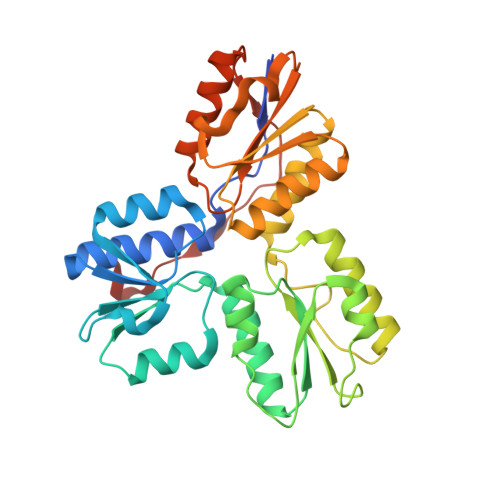Probing the reaction mechanism of IspH protein by x-ray structure analysis.
Grawert, T., Span, I., Eisenreich, W., Rohdich, F., Eppinger, J., Bacher, A., Groll, M.(2010) Proc Natl Acad Sci U S A 107: 1077-1081
- PubMed: 20080550
- DOI: https://doi.org/10.1073/pnas.0913045107
- Primary Citation of Related Structures:
3KE8, 3KE9, 3KEF, 3KEL, 3KEM - PubMed Abstract:
Isopentenyl diphosphate (IPP) and dimethylallyl diphosphate (DMAPP) represent the two central intermediates in the biosynthesis of isoprenoids. The recently discovered deoxyxylulose 5-phosphate pathway generates a mixture of IPP and DMAPP in its final step by reductive dehydroxylation of 1-hydroxy-2-methyl-2-butenyl 4-diphosphate. This conversion is catalyzed by IspH protein comprising a central iron-sulfur cluster as electron transfer cofactor in the active site. The five crystal structures of IspH in complex with substrate, converted substrate, products and PP(i) reported in this article provide unique insights into the mechanism of this enzyme. While IspH protein crystallizes with substrate bound to a [4Fe-4S] cluster, crystals of IspH in complex with IPP, DMAPP or inorganic pyrophosphate feature [3Fe-4S] clusters. The IspH:substrate complex reveals a hairpin conformation of the ligand with the C(1) hydroxyl group coordinated to the unique site in a [4Fe-4S] cluster of aconitase type. The resulting alkoxide complex is coupled to a hydrogen-bonding network, which serves as proton reservoir via a Thr167 proton relay. Prolonged x-ray irradiation leads to cleavage of the C(1)-O bond (initiated by reducing photo electrons). The data suggest a reaction mechanism involving a combination of Lewis-acid activation and proton coupled electron transfer. The resulting allyl radical intermediate can acquire a second electron via the iron-sulfur cluster. The reaction may be terminated by the transfer of a proton from the beta-phosphate of the substrate to C(1) (affording DMAPP) or C(3) (affording IPP).
Organizational Affiliation:
Center for Integrated Protein Science, Department Chemie, Lehrstuhl f¨¹r Biochemie, Technische Universit?t M¨¹nchen, Lichtenbergstrasse 4, Garching, Germany.


















